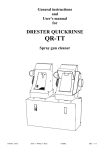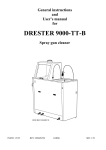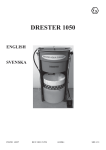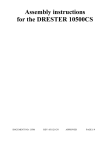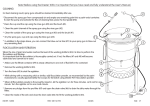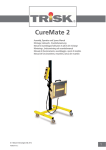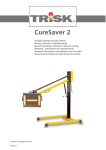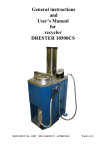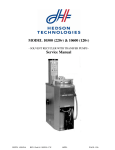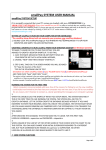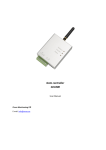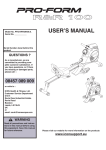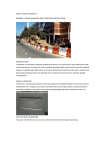Download General instructions and User`s Manual for spray gun cleaner
Transcript
General instructions and User’s Manual for spray gun cleaner DRESTER 3600GC DOC. NO.: 13552 REV: 050422/NJ APPR: PAGE: 1/16 CAUTION Read the General instructions and User’s Manual before using the DRESTER 3600GC. Do not use the equipment unless you fully understand the General instructions and User’s Manual. The User’s Manual must be available when using the unit. GENERAL INFORMATION This User’s Manual will provide important information concerning the DRESTER 3600GC, and will describe how to use the gun cleaner safely. Read the entire User’s Manual before using the unit. For safe use, it is important that the unit, the drums and the solvent are of the described specifications, and that they are handled properly. It is important that you follow the instructions carefully. The DRESTER 3600GC utilizes drums of solvent for cleaning. Drums and solvent for use with the unit is not provided by Hedson Technologies. On the market there are numerous drums and solvents, and Hedson Technologies cannot account for them all. Never use any solvent unless it is provided with an MSDS (Material Safety Data Sheet). Read the MSDS carefully, and follow all the instructions and procedures provided in the MSDS. Only use drums as specified in the instructions. More information regarding allowed drums and solvents can be found under the chapters PERMITTED SOLVENTS and PERMITTED DRUMS. PURPOSE OF THE MACHINE The DRESTER 3600GC is intended to clean air-driven spray guns only, using thinner-based solvents. SAFETY INFORMATION Hazards may arise from improper use of the DRESTER 3600GC. Hazards may also arise from improper choice/handling of drums or solvent. In order to maintain the high safety standard of the unit, it is important that these instructions are followed. - Do not operate the unit until you have read and fully understood this entire User’s Manual. The unit should be intalled as described in the instructions. The unit should be used as described in the instructions. The unit should be maintained as decribed in the instructions. Only original spare parts may be used. This User’s Manual must be available and in legible condition in close proximity to the unit. Every user shall know where to find the User’s Manual. Operating instructions should be formulated on the basis of these General Instructions and User’s Manual for DRESTER 3600GC, and translated into the language spoken by the employees. 2 - - - - Do not modify or in any way alter the unit. Do not operate the unit unless it is properly vented. The extractor should be connected to a grounded metal ducting vented outside. Do not operate the unit if the extraction of vapors is insufficient. Avoid contact with liquid and vapor. Refer to the solvents’ MSDS (Material Safety Data Sheet). Wear chemical goggles or similar, to protect your eyes. Wear chemical-resistant gloves to prevent skin-contact. Wear chemical-resistant clothing to protect against spills or splash. Personnel suffering from respiratory problems or allergies to the solvents used, must not operate the machine. Clean up spills immediately. Solvent vapors are heavier than air and can spread a long way. They may also collect in pits or other low areas. Do not smoke, eat or drink while close to the unit. The unit is equipped with a safety valve that will interrupt the automatic wash cycle if the lid is opened before the wash cycle is completed. A fire extinguisher (dry chemical type ABC, dry chemical type BC, foam, carbon dioxide or Halon) must always be kept nearby when working with flammable solvents. Do not use water. Spray guns cleaned in the unit must be suitable for cleaning in gun cleaning machines classified as Class 1, Division 1 / Zone 1. If unsure, please contact the spray gun manufacturer. The unit must be properly grounded using the attached clamps. The solvent drums should be properly grounded using the attached clamps. If plastic drums are used, the openings should be wiped off with a damp cloth, to avoid static electricity, before inserting or removing any hoses or other equipment. PERMITTED SOLVENTS Solvent for use with the DRESTER 3600GC is not provided by Hedson Technologies. On the market, there are numerous solvents and these instructions cannot account for them all. Only use the unit with solvents intended for spray gun cleaning, such as lacquer thinner. Lacquer thinner is a generic term for solvent mixtures, commonly containing such ingredients as e.g. Acetone, Toluene, Xylene and iso-Butanol. The unit can be used with solvents classified as Group IIA according to IEC 60079-20. The unit can also be used with water. All solvents must have a pH value between 4 and 10. Be sure not to mix water-based solvents with thinner-based solvents. It is important that all users are informed of what solvent is being used, at all times. Never use any solvent if it is not provided with an MSDS (Material Safety Data Sheet). Read the MSDS carefully, and follow all the instructions and procedures provided in the MSDS. If unsure, or if more information is needed concerning the solvent, please contact your solvent supplier. Do not add other chemicals to the solvent including, but not limited to, kerosene, gasoline, detergents, fuel oil or chlorinated solvents. PERMITTED DRUMS It is important that the drums fit the gun cleaner properly, for safe use. There are several types of solvent drums on the market. The DRESTER 3600GC can be used with different types of drums and bungs, but they must comply with the following: - The drums must be leak-free. - The drums must fit inside the enclosed circular spillage tray with an inner diameter of 14.2”. - The drums must not be taller than 18.5”. - The bung’s inner diameter must not be bigger than 2.6”. 3 - The bung must be big enough to accommodate 2 hoses, 0.61” and 0.82” respectively (see picture 1). Solvent drums are not provided by Hedson Technologies, thus Hedson Technologies does not take any responsibility for the drums. Follow the solvent supplier’s instructions carefully. For more information concerning drums, bungs etc, please see chapter PREPARATIONS FOR USE. ASSEMBLY See separate “Assembly instructions for spray gun cleaner DRESTER 3600GC”, (document no. 13582). PLACING THE UNIT Area classification The DRESTER 3600GC can be placed in locations classified as Class 1, Division 1 / Zone 1. If the DRESTER 3600GC is installed in locations classified as Class 1, Division 2 / Zone 2, or in unclassified locations, the area within 5 feet from the unit is to be classified as Class 1, Division 1 / Zone 1. Outside said area, another 3 feet is to be classified as Class 1, Division 2 / Zone 2 (see picture 2). Within these classified areas of Class 1, Division 1 / Zone 1 and Class 1, Division 2 / Zone 2, all equipment, such as electrical items and ventilation equipment, must be approved for the applicable Division / Zone. Equipment that generates naked flames or sparks (e.g. welding or grinding equipment) may not be used in this area. Smoking is not permitted. If in any doubt, contact the local fire service authorities for advice. Fire extinguisher A fire extinguisher (dry chemical type ABC, dry chemical type BC, foam, carbon dioxide or Halon) must always be kept nearby when working with flammable solvents. Do not use water. Drain water protection The unit must be placed in a location where any accidental leakage of solvent is prevented from spreading into the drain water system. INSTALLATION Compressed air Fit a quick-coupling to the air line on the left side of the unit (see picture 3). This air line is used if you want to blow out the spray gun manually, after the cleaning procedure. The unit must be connected to compressed air of 90-175 psi (6-12 bar). The air connection (1/4” female thread) is at the back of the unit (see picture 4, item 1). When connected, open the main valve (see picture 4, item 2) slowly, to spare the pneumatics from a pressure blast. When running an automatic wash, the air consumption is 3.5 cfm (100 liters/min). When having the lid open and using the manual rinse nozzle, the unit temporarily consumes up to 9 cfm (250 liters/min) of air. To prevent pressure drops, the air-line and couplings must be adequately dimensioned for air pressures and flows as stated above. The pressure regulator on the unit is preset to 87 psi (6 bar). The compressed air supplied to the unit must be clean, dry and free from oil. Otherwise, it may cause damage to the pneumatic components of the unit, and any warranty claims will be invalidated. 4 Ventilation The air-driven extractor should be connected to a grounded metal ducting, with a smooth inner surface, to lead the exhausts outdoors (see picture 5). Alternatively, lead the metal ducting into a hood, which is in turn connected to a suitable ventilation system approved for Class 1, Division 1 / Zone 1. Such a hood should have an open design to avoid constant extraction (see picture 5). The metal ducting may not be longer than 50 feet, and must be connected in a way ensuring that it is grounded. Grounding Securely ground the unit, using the main ground clamp on the back of the unit (see picture 6, item 1). Also ground the drums, using the grounding clamps (see picture 6, item 2). If using painted drums, scrape off some paint to ensure proper contact for the ground clamps. PREPARATIONS FOR USE Solvent drums Two drums are needed, one drum that is empty, and one drum full of solvent. Both drums must be of the same size, and they must meet the requirements described under chapter PERMITTED DRUMS. Both drums must be clean on the inside and they must not contain any solids or other objects that could be sucked into the pumps when running. Drum plugs There are several types of solvent drums on the market. DRESTER 3600GC can be used with different types of drums and bungs. Read these instructions and chose the setup suitable for your kind of drums. Depending on the appearance of the bungs, the hoses are led through the bungs in different ways. Enclosed are drum plugs (see picture 7, item 1) that can be used with different bung sizes. The drum plugs can be used with or without the enclosed drum plug collars (see picture 7, item 2). The drum plug collars are tapered to fit different sized bungs. 1. If the diameter of the drum bungs is more than 1.6”, then use the drum plugs. If the drum plug collars fit into your bungs, use them together with the drum plugs (see picture 8). 2. If the solvent drums have got flexible pull-up spigots, with bung diameters less than 1.6”, then no drum plugs are used. When using such drums, it is usually practical to have the flexible spigot pushed down when used with the DRESTER 3600GC (see picture 1). This makes it easier to fit the hoses. Solvent fill-up Place the spillage tray on the floor, inside the gun cleaner’s foot plate (see picture 9, item 1). Use one empty drum and another identical drum full of clean solvent. Place the first drum, the empty one, underneath the unit. Fit the drain hose into the drum together with the ½” black grooved suction hose. Use drum plugs as described earlier under section Drum plugs. If a drum plug is fitted (see picture 9, item 2), use the drum plug with 2 holes. Make sure that the hoses are properly led into the drum. Open the gun cleaner’s lid. Take the second drum, the one full of solvent, and pour half of its contents into the gun cleaner’s washing compartment. The solvent that is poured in will drain into the drum underneath the gun cleaner. Place the second drum, now half full, on the floor on the right-hand side of the gun cleaner. Fit the black ¼” solvent line, into the drum. Do not bend the hose more than necessary. Use drum plugs as described above under section Drum plugs. If a drum plug is fitted, use the drum plug with 5 1 hole. Make sure that the hose is properly led into the drum. Now, the solvent system is filled-up. Both drums should be half full. The drum underneath the unit contains the solvent that will be recirculating for the automatic wash cycle, and the right-hand drum contains clean solvent for manual rinsing. Preparing the air purge lines To prevent contaminated solvent from enetering the spray gun’s air channels while being washed, the unit utilizes an air purge line. The air purge line should be fitted with a tapered plug that fits into the spray gun’s air inlet. Depending on what model of air-connection you use on your spray gun, there are different tapered plugs to fit all models. Pick the tapered plug that fits your type of air-connection (see picture 10). Break it off and fit it to the air purge line. There are two air purge lines to fit both gravity-fed spray guns and suction-type spray guns. Fit both lines with tapered plugs. Operating instructions Operating instructions should be formulated on the basis of these General Instructions and User’s Manual for DRESTER 3600GC, and translated into the language spoken by the employees. Instructions should always be available close to the machine. To avoid confusion, all employees must be informed about the solvent currently being used in the unit. OPERATING INSTRUCTIONS Before cleaning a spray gun, empty any residual paint into a separate spills-dish. This is important to avoid over-filling of the drums. 1. 2. 3. 4. 5. 6. 7. 8. Disassemble the spray gun. Place the spray gun’s cup and cup lid on the spray cradle (see pictures 12 and 13). Fit the trigger clip (see picture 11). Place the spray gun on the spray cradle (see pictures 12 and 13). Note: Gravity fed spray guns require an extension pipe. Several extension pipes are provided, to fit most spray guns (see picture 15). Fit a suitable extension pipe before placing the spray gun on the spray cradle (see picture 14, item 2). Connect the air purge line (see picture 12, item 1 and picture 13, item 1). Close the lid, and start the automatic wash by turning the on/off-lever on the top of the unit (see picture 15). The spray gun will now be automatically cleaned, inside and outside, for as long as the lever stays turned. When the automatic cleaning procedure is completed, the lid can be opened and the spray gun can be taken out. It can now be manually rinsed with clean solvent, if required. If the foot pedal (see picture 15) is pressed, a spray of clean solvent will come from the nozzle under the lid (see picture 16, item 1). The vapors are removed by the extractor, which is automatically activated when the lid is open. Finally, it is possible to blow out the spray gun. Connect the spray gun to the air line on the left side of the machine (see picture 3), and blow out the spray gun through the funnel under the lid (see picture 16, item 2). By using this funnel, you vapors are prevented from spreading within the premises. Close the lid after cleaning. 6 SERVICE AND MAINTENANCE Weekly: - Remove the spray cradle by loosening the center bolt. Remove the strainer at the bottom of the washing compartment and clean it. Wipe off any contaminants and paint residuals inside the washing compartment. - Make sure the User’s Manual is legible and in a place where all users can find it. - Make sure all decals are legible. - Test the lid’s safety valve. Start an automatic wash and then raise the lid 1 inch. Do not raise the lid more than 1 inch, since solvent may exit the washing compartment. The unit shall stop operating immediately. If not, stop using the unit and contact your supplier. When changing drums: - Follow the instructions under section Solvent drums. - Check for any damages on the drums and hoses. Replace if damaged. Monthly: - Remove the seven spray nozzles (see picture 17) and clean them with clean solvent. - Check hoses for any damages. Replace if damaged. Yearly: - Remove the extractor. Check the air-jet nozzle in the middle of the extractor. If there is paint build-up on the nozzle, replace it. 7 TECHNICAL DATA Manufacturer: HEDSON TECHNOLOGIES AB Hammarvägen 4 SE-232 37 Arlöv Sweden Type of machine: Permitted solvents: Compressed air needed: Extraction capacity: DRESTER 3600GC See section PERMITTED SOLVENTS 90-175 psi (6-12 bar), 9 cfm (250 l/min) 82 cfm (140 m3/hour) (with a 50 feet / 15 m extension) 106 cfm (180 m3/hour) (with a 16 feet / 5 m extension) 2.65 gallons per minute (10 liters per minute) 45 psi (3 bar) 66 lbs (30 kg) 5” (125 mm) 71 dB(A) measured at a distance of 1 m 85 dB(A) See below. Pump capacity: Solvent pressure: Weight: Extractor diameter: Sound pressure level: Sound power level: Overall dimensions: 8 Picture 1 Picture 2 Picture 3 9 Picture 4 Vapor extraction layout options: Picture 5 10 Picture 6 Picture 7 11 Picture 8 2 1 Picture 9 12 Picture 10 Picture 11 1 Picture 12 13 2 1 Picture 13 Picture 14 Picture 15 14 Picture 16 Picture 17 15 16
















